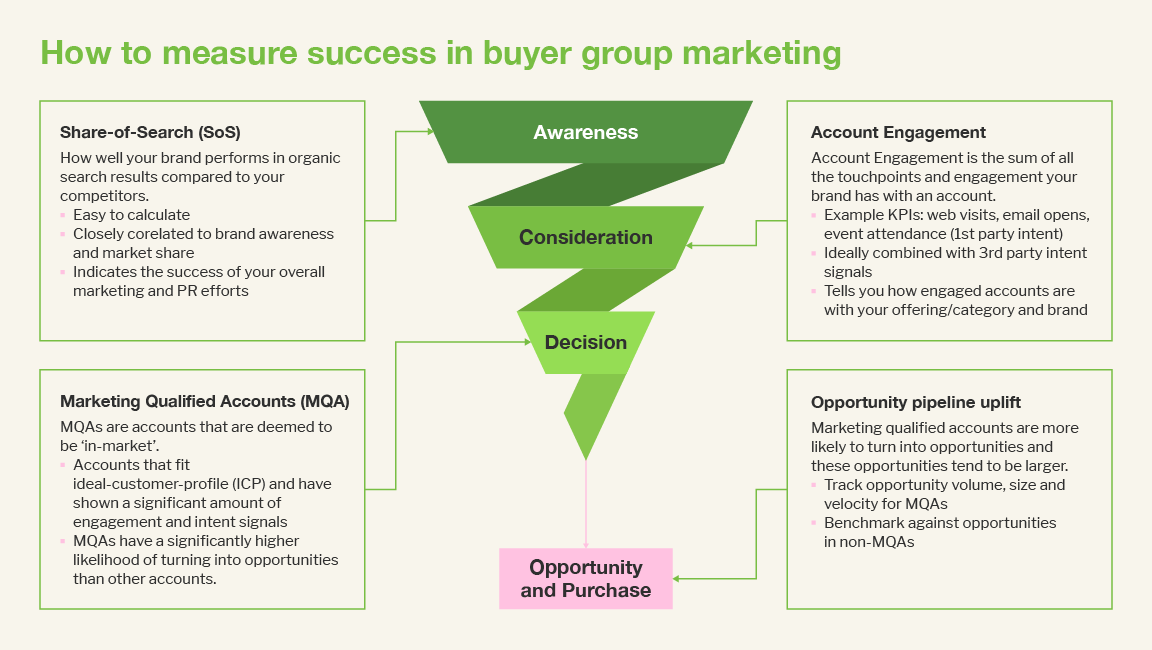Why MQLs are dead and how to measure marketing success instead.
How many marketers does it take to screw in a light bulb? None. We’ve automated it.
And how many salespeople does it take to change a light bulb? None. "You don't need a new light bulb - you need to upgrade your lamp to the newest version."
Ok, that’s enough with the stereotypes and lightbulb jokes, but they make for a good introduction to an important question in B2B marketing:
How many people does it take to make a buying decision?
The answer of course varies by industry and what you sell, but for any high-value product or service it will inevitably be: More than 1 – and quite likely close to 10. Green Hat’s APAC B2B Buyer Journey Research puts the average buying party in B2B in APAC at 12.8 people.
Marketers know this, yet some still cling to the belief that all it takes to be prove marketing impact is for leads to fill out a form, to declare these individuals ‘MQLs’ (Marketing Qualified Leads) and send them to sales who are eagerly awaiting their arrival – only to convert them into pipeline and sales immediately.
Wouldn’t it be great if life was that easy? Most marketers know that’s not the case of course but are still measured against MQL targets.
One marketer went as an MQL for Halloween because ‘MQLs are dead’
MQLs have been declared dead for years. Drift wrote a whole eBook on the topic recently while Gartner’s Todd Berkowitz wrote the first obituary in 2017 – that’s so long ago that Gartner doesn’t even list his article on their site anymore.
Here’s a list of six reason while MQLs suck as indicators for marketing success – and I’m sure you could come up with a few more.
- Individuals don’t make buying decisions – groups of people do. It’s a buying party after all.
- There is a huge timing issue: If you get a form fill from one individual in a buying party at the start of a 13-month buying journey (the average in APAC according to our research), and you then put them into a nurture stream followed by SDR outreach they still won’t be ready to talk to you until they are 73% through their decision-making process as proven by our APAC B2B Buyer Journey Research.
- The Q for qualified is reliant on a robust scoring model. There are not many of those around, and even the best model will only ever give you a score for the individual – not the multiple other people that have a say in the matter.
- Most salespeople hate MQLs. Does that sound harsh? Have a look at the number of MQLs in your CRM that have not been touched by sales within the timeframe they’ve agreed on. Sellers don’t work MQLs because MQLs don’t work.
When marketing says – it’s an MQL, we are really saying “We think this might be a good lead, but we don’t know, sales can you check it and tell us?” - Marketers get addicted to MQLs, because they are an easy metric to report on and are readily available: with the right investment in the right channels, and a – shall we say ‘sympathetic’ scoring model – any marketer can generate hundreds of MQLs. And they need to, because on average only 1 out of 100 MQLs ever leads to a sale, according to Forrester.
- The demand for quantity often leads to questionable quality, which can put further pressure on this 100:1 ratio, and makes sellers dislike MQLs even more.
A better (and healthier) alternative: the MQA
So, to kick any bad habit or addiction, we need a better, healthier substitute.
Enter Marketing Qualified Accounts.
MQAs promise to solve most of the problems marketers have with MQLs:
- MQAs give a picture of how an entire account is engaging, therefore acknowledging that it’s not individual leads who make buying decisions.
- Successful sales teams have worked accounts rather than leads for decades. They ‘multi-thread’ by engaging multiple decision makers and influencers. Now marketers can show that they’re doing the same – and have done for a long time. Because while marketers have worked to generate form fills and engagement from individuals, they have inevitably done so across multiple contacts in accounts. With a focus on MQAs marketers now combine all these ‘buying signals’ into a coherent view of an account’s likelihood to buy.
- This will lead to closer alignment between marketing and sales. After all, you’re now not generating leads that salespeople hate, but instead share a common goal of moving accounts through the funnel. Some of the most forward-thinking companies have cemented this with shared KPIs across the go-to-market teams.
- MQAs are much more likely to turn into opportunities. Rather than the 1% rate that Forrester reports for MQLs, we’ve seen MQA conversion rates of up to 20% with our clients. Alongside larger deal values.
- MQAs are a natural fit with Account Based Marketing (ABM) and the notion that rather than ‘boiling the ocean’, modern B2B marketers should focus their attention and resources on the accounts that are most likely to buy.
It’s a trap!
And while we’re on the topic of kicking bad habits, let’s also stop the bad but incredibly widespread practice of hiding our best content behind forms.
Our prospective buyers hate forms nearly as much as sellers hate MQLs. Why? Because they know that forms are a trap, and that what happens next is nurture emails – or worse unsolicited sales calls.
No wonder then that less than 3% of web visitors fill out forms, and that the more senior a prospective buyer is, the less likely they’ll divulge their data to receive your latest whitepaper.
When you spend a lot of money and time to produce awesome content that could really influence the buying decision, why hide it behind forms and make it harder for your buyers to find it?
I’ll tell you why: because of our aforementioned addiction to MQLs and the perceived need to proof the effectiveness of content by collecting the contact details of everyone who accesses it.
If MQAs are the goal, then individual form fills are no longer critical.
Instead, trust in the power of your content and trust that it will reach the decision makers – especially the more senior ones, if it’s no longer hidden behind forms.
I’m not saying to get rid of forms altogether of course, but to simply use them only in cases where we cannot deliver our content without knowing a few key contact details – think webinars and events.
And if you must use forms, make them as short as possible. There’s no excuse to have forms with more than a handful of fields, if you can use technology to auto-fill most information based on an email address.
How to measure marketing success without MQLs

So, if you get rid of most of your forms, you will end up with less MQLs. But how do you measure the effectiveness of you marketing efforts then?
We suggest that instead of counting the number of MQLs, we should measure marketing success along 4 key performance indicators:
- Share-of-Search (SoS)
First established in 2020 Share-of-Search is an effective metric to measure brand awareness by monitoring how your brand is growing (or declining) in terms of branded (Google) searches – relative to those of your competitors.
Unlike the more traditional Share-of-Voice (SoV) metric, Share-of-Search provides insights into how marketing efforts and campaigns are directly influencing your brand.
Your Share-of-Search also correlates with your Share-of-Market (SoM) - the more your brand is searched for, the higher your market share – making it a great metric to track marketing performance and proof return on brand invest. - Account Engagement
Account Engagement is the sum of all the touchpoints and engagement your brand has with the individuals in an account. What we’re tracking here are standard marketing metrics such as web visits, interactions on socials, email engagement, event attendance and the like. This is your 1st party intent – the engagement within your brand universe.
But we also need the technology to detect 3rd party intent – outside of your brand universe - and to de-anonymise website traffic.
As always, it’s about quality not quantity. We need to reach the right contacts. Read: all members of the 12.8 people strong buying party – with the right message, through the right channels at the right time.
And to add to the lists of ‘rights’, I would argue that you should also consider the right accounts. At the very least define hyper-targeted ideal-customer-profiles (ICP), or better yet develop an account-based approach and strategically select the accounts that promise the biggest opportunities.
When we get all the ‘rights’ right, we move accounts and their buying groups through the funnel and create: - Marketing Qualified Accounts
I’ve given you the reasons why MQAs are better than MQLs earlier, now let’s talk about how you can tell if an account is qualified or not.
What we mean by ‘qualified’ here is whether and account is ‘in-market’ or not. We need predictive capabilities that analyse all the signals from an account - 1st and 3rd party intent – to determine if the sum of these engagements indicates a higher-than-normal level of research on a certain topic and therefor a higher propensity to buy. This is of course best achieved through platforms like 6sense or DemandBase, but there are more cost-effective solutions like Green Hat’s Data Insights as a Service (DIaaS) as well. - Opportunity pipeline uplift
This is where the rubber hits the road, so to speak. And this is where your sales and finance colleagues get excited. As mentioned earlier, marketing qualified accounts are more likely to turn into opportunities and these opportunities tend to be larger. Now we need build reporting dashboards that prove this.
We’ve worked with many clients on their transition from MQL to MQA-based marketing and we always compare key opportunity-related KPIs like volume, size and velocity of opportunities that resulted from MQAs vs those that came from MQLs. And it probably doesn’t come as a surprise to you that MQA opportunities significantly outperform MQL opportunities.
This is the story we need to tell our sale and finance colleagues when we finally announce that we are giving up on MQLs: marketing-qualified accounts help us generate more opportunities and revenue, because they are much more closely aligned to how B2B buying decisions are actually made.
All the proof-points you need for this critical conversation are in our APAC B2B Buyer Journey Research. Since we’ve launched the research, we’ve discussed the findings with countless senior business and sales leaders – with the strong consensus that we need to re-think the way we do our marketing (and overcome our addiction to MQLs).
Now it’s your turn – and we are of course here to help you facilitate the discussion.

 ABM
ABM Strategy
Strategy Demand Generation
Demand Generation

.png)

.png?width=900&name=shutterstock_2484595495%201%20(1).png)
